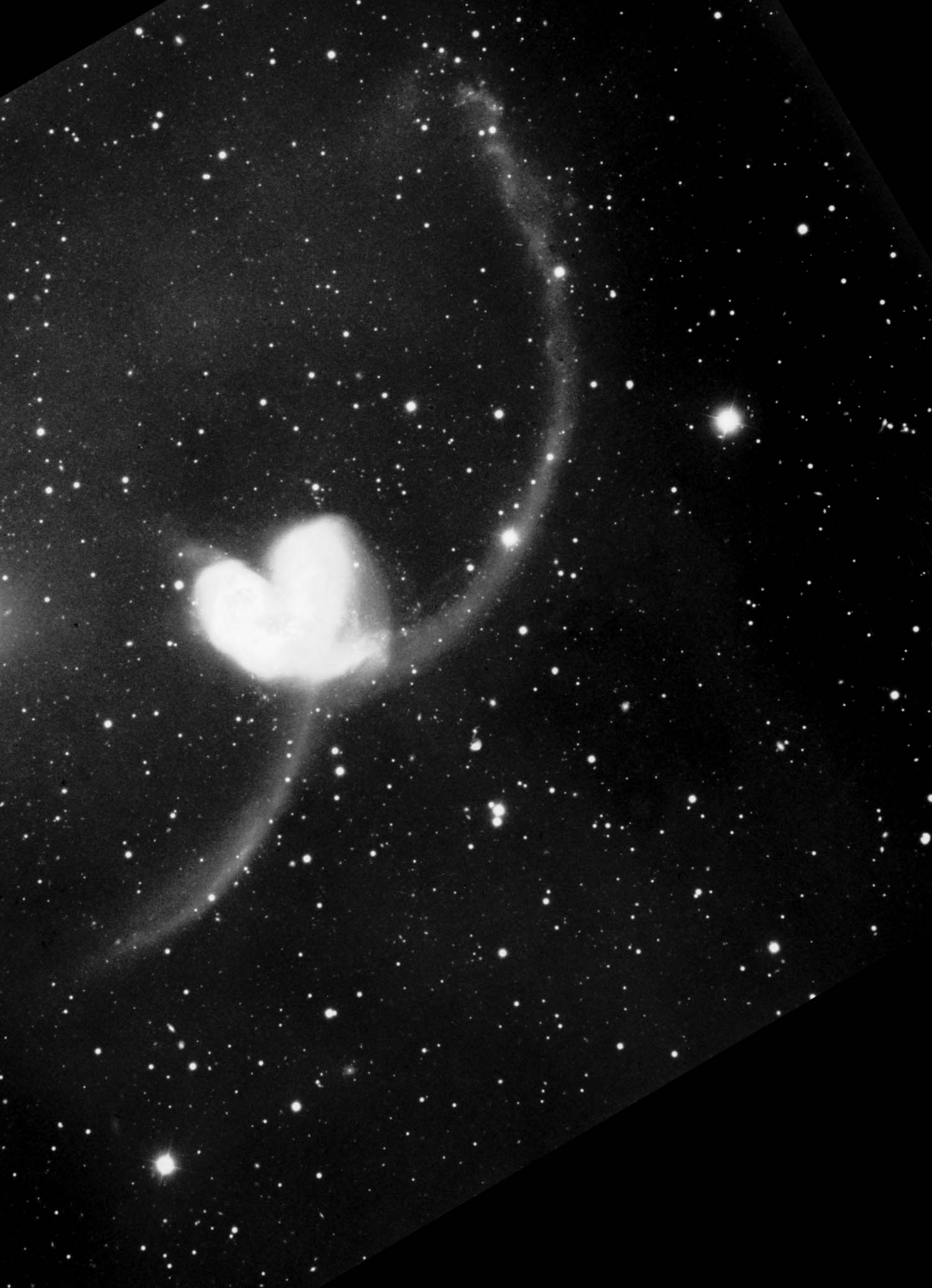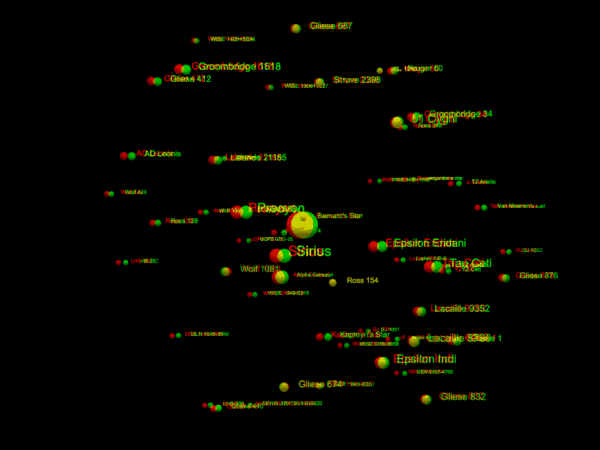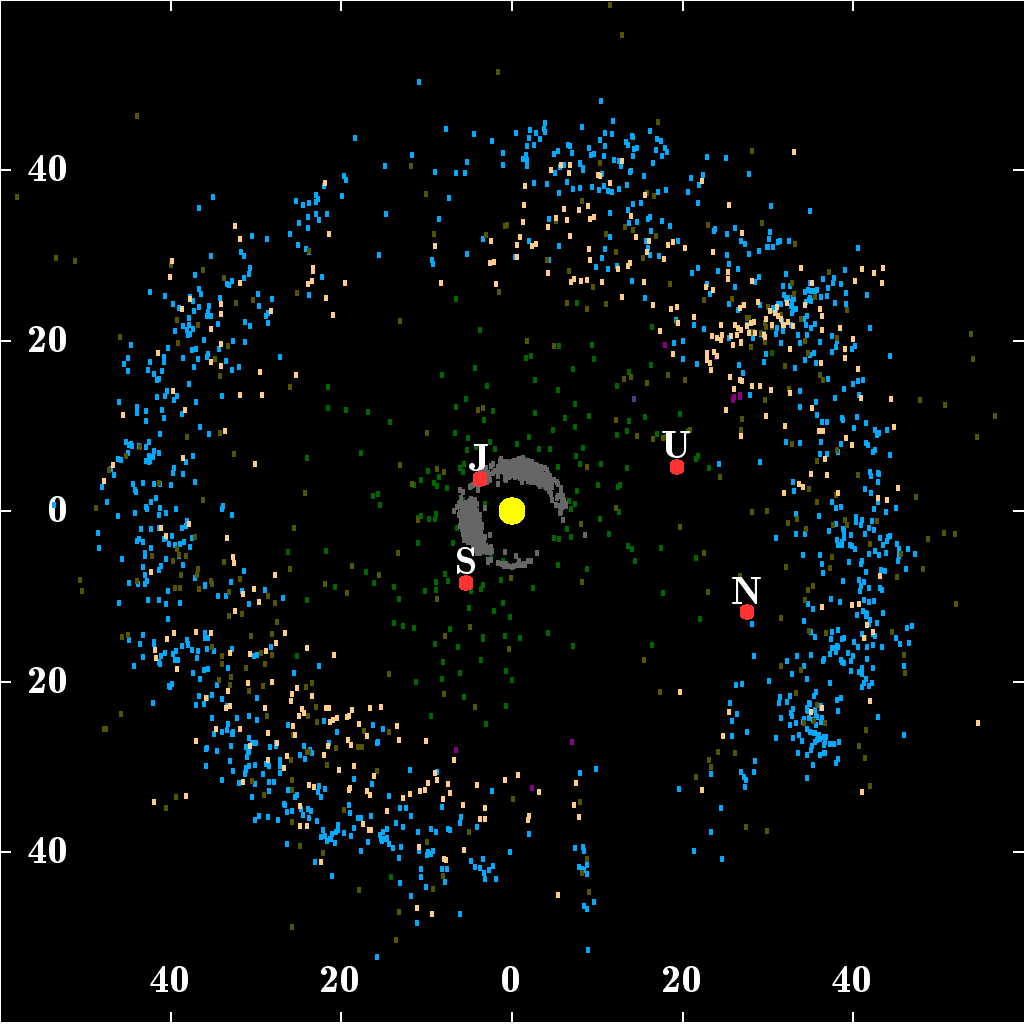|
Cometary Object Articles
A comet is an icy, small Solar System body that, when passing close to the Sun, warms and begins to release gases, a process that is called outgassing. This produces a visible atmosphere or coma, and sometimes also a tail. These phenomena are due to the effects of solar radiation and the solar wind acting upon the nucleus of the comet. Comet nuclei range from a few hundred meters to tens of kilometers across and are composed of loose collections of ice, dust, and small rocky particles. The coma may be up to 15 times Earth's diameter, while the tail may stretch beyond one astronomical unit. If sufficiently bright, a comet may be seen from Earth without the aid of a telescope and may subtend an arc of 30° (60 Moons) across the sky. Comets have been observed and recorded since ancient times by many cultures and religions. Comets usually have highly eccentric elliptical orbits, and they have a wide range of orbital periods, ranging from several years to potentially several mil ... [...More Info...] [...Related Items...] OR: [Wikipedia] [Google] [Baidu] |
Comet Nucleus
The nucleus is the solid, central part of a comet, once termed a ''dirty snowball'' or an ''icy dirtball''. A cometary nucleus is composed of Rock (geology), rock, dust, and frozen gases. When heated by the Sun, the gases Sublimation (physics), sublime and produce an atmosphere surrounding the nucleus known as the Coma (cometary), coma. The force exerted on the coma by the Sun's radiation pressure and solar wind cause an enormous tail to form, which points away from the Sun. A typical comet nucleus has an Albedo#Astronomical albedo, albedo of 0.04. This is blacker than coal, and may be caused by a covering of dust. Results from the Rosetta (spacecraft), ''Rosetta'' and Philae (spacecraft), ''Philae'' spacecraft show that the nucleus of 67P/Churyumov–Gerasimenko has no magnetic field, which suggests that magnetism may not have played a role in the early formation of planetesimals. Further, the Rosetta (spacecraft)#Instruments, ALICE spectrograph on ''Rosetta'' determined that ... [...More Info...] [...Related Items...] OR: [Wikipedia] [Google] [Baidu] |
Astronomical Unit
The astronomical unit (symbol: au, or or AU) is a unit of length, roughly the distance from Earth to the Sun and approximately equal to or 8.3 light-minutes. The actual distance from Earth to the Sun varies by about 3% as Earth orbits the Sun, from a maximum (aphelion) to a minimum (perihelion) and back again once each year. The astronomical unit was originally conceived as the average of Earth's aphelion and perihelion; however, since 2012 it has been defined as exactly (see below for several conversions). The astronomical unit is used primarily for measuring distances within the Solar System or around other stars. It is also a fundamental component in the definition of another unit of astronomical length, the parsec. History of symbol usage A variety of unit symbols and abbreviations have been in use for the astronomical unit. In a 1976 resolution, the International Astronomical Union (IAU) had used the symbol ''A'' to denote a length equal to the astronomical ... [...More Info...] [...Related Items...] OR: [Wikipedia] [Google] [Baidu] |
Hyperbolic Comet
This is a list of parabolic and hyperbolic comets in the Solar System. Many of these comets may come from the Oort cloud, or perhaps even have interstellar origin. The Oort Cloud is not gravitationally attracted enough to the Sun to form into a fairly thin disk, like the inner Solar System. Thus, comets originating from the Oort Cloud can come from roughly any orientation (inclination to the ecliptic), and many even have a retrograde orbit. By definition, a hyperbolic orbit means that the comet will only travel through the Solar System once, with the Sun acting as a gravitational slingshot, sending the comet hurtling out of the Solar System entirely unless its eccentricity is otherwise changed. Comets orbiting in this way still originate from the Solar System, however. Typically comets in the Oort Cloud are thought to have roughly circular orbits around the Sun, but their orbital velocity is so slow that they may easily be perturbed by passing stars and the galactic tide. Astr ... [...More Info...] [...Related Items...] OR: [Wikipedia] [Google] [Baidu] |
Galactic Tide
A galactic tide is a tidal force experienced by objects subject to the gravitational field of a galaxy such as the Milky Way. Particular areas of interest concerning galactic tides include galactic collisions, the disruption of dwarf or satellite galaxies, and the Milky Way's tidal effect on the Oort cloud of the Solar System. Effects on external galaxies Galaxy collisions Tidal forces are dependent on the gradient of a gravitational field, rather than its strength, and so tidal effects are usually limited to the immediate surroundings of a galaxy. Two large galaxies undergoing collisions or passing nearby each other will be subjected to very large tidal forces, often producing the most visually striking demonstrations of galactic tides in action. Two interacting galaxies will rarely (if ever) collide head-on, and the tidal forces will distort each galaxy along an axis pointing roughly towards and away from its perturber. As the two galaxies briefly orbit each other, thes ... [...More Info...] [...Related Items...] OR: [Wikipedia] [Google] [Baidu] |
List Of Nearest Stars
This list covers all known stars, brown dwarfs, and sub-brown dwarfs within of the Sun. So far, 131 such objects have been found, of which only 22 are bright enough to be visible without a telescope. The visible light needs to reach or exceed the dimmest brightness to be visible to the naked eye from Earth, 6.5 apparent magnitude. The known 131 objects are bound in 94 stellar systems. Of those, 103 are main sequence stars: 80 red dwarfs and 23 "typical" stars having greater mass. Additionally, astronomers have found 6 white dwarfs (stars that have exhausted all fusible hydrogen), 20 brown dwarfs, as well as 2 sub-brown dwarfs: WISE 0855−0714 (probably a rogue planet) and WISE 1741+2553. The closest system is Alpha Centauri, with Proxima Centauri as the closest star in that system, at 4.2465 light-years from Earth. The brightest, most massive and most luminous object among those 131 is Sirius A, which is also the brightest object in Earth's night sky; its white dwarf com ... [...More Info...] [...Related Items...] OR: [Wikipedia] [Google] [Baidu] |
Gravitational Perturbation
In astronomy, perturbation is the complex motion of a massive body subjected to forces other than the gravitational attraction of a single other massive body. The other forces can include a third (fourth, fifth, etc.) body, resistance, as from an atmosphere, and the off-center attraction of an oblate or otherwise misshapen body. Introduction The study of perturbations began with the first attempts to predict planetary motions in the sky. In ancient times the causes were unknown. Isaac Newton, at the time he formulated his laws of motion and of gravitation, applied them to the first analysis of perturbations, recognizing the complex difficulties of their calculation. Many of the great mathematicians since then have given attention to the various problems involved; throughout the 18th and 19th centuries there was demand for accurate tables of the position of the Moon and planets for marine navigation. The complex motions of gravitational perturbations can be broken down. The ... [...More Info...] [...Related Items...] OR: [Wikipedia] [Google] [Baidu] |
Oort Cloud
The Oort cloud (), sometimes called the Öpik–Oort cloud, first described in 1950 by the Dutch astronomer Jan Oort, is a theoretical concept of a cloud of predominantly icy planetesimals proposed to surround the Sun at distances ranging from 2,000 to 200,000 AU (0.03 to 3.2 light-years).The Oort cloud's outer limit is difficult to define as it varies over the millennia as different stars pass the Sun and thus is subject to variation. Estimates of its distance range from 50,000 to 200,000 au. It is divided into two regions: a disc-shaped inner Oort cloud (or Hills cloud) and a spherical outer Oort cloud. Both regions lie beyond the heliosphere and are in interstellar space. The Kuiper belt, the scattered disc and the detached objects, the other three reservoirs of trans-Neptunian objects, are less than one thousandth as far from the Sun as the Oort cloud. The outer limit of the Oort cloud defines the cosmographic boundary of the Solar System and the extent of the Sun's Hill ... [...More Info...] [...Related Items...] OR: [Wikipedia] [Google] [Baidu] |
Long Period
Long may refer to: Measurement * Long, characteristic of something of great duration * Long, characteristic of something of great length * Longitude (abbreviation: long.), a geographic coordinate * Longa (music), note value in early music mensural notation Places Asia * Long District, Laos * Long District, Phrae, Thailand * Longjiang (other) or River Long (lit. "dragon river"), one of several rivers in China * Yangtze River or Changjiang (lit. "Long River"), China Elsewhere * Long, Somme, France * Long, Washington, United States People * Long (surname) * Long (surname 龍) (Chinese surname) Fictional characters * Long (''Bloody Roar''), in the video game series Sports * Long, a fielding term in cricket * Long, in tennis and similar games, beyond the service line during a serve and beyond the baseline during play Other uses * , a U.S. Navy ship name * Long (finance), a position in finance, especially stock markets * Lòng, name for a laneway in Shanghai * Long in ... [...More Info...] [...Related Items...] OR: [Wikipedia] [Google] [Baidu] |
Neptune
Neptune is the eighth planet from the Sun and the farthest known planet in the Solar System. It is the fourth-largest planet in the Solar System by diameter, the third-most-massive planet, and the densest giant planet. It is 17 times the mass of Earth, and slightly more massive than its near-twin Uranus. Neptune is denser and physically smaller than Uranus because its greater mass causes more gravitational compression of its atmosphere. It is referred to as one of the solar system's two ice giant planets (the other one being Uranus). Being composed primarily of gases and liquids, it has no well-defined "solid surface". The planet orbits the Sun once every 164.8 julian year (astronomy), years at an average distance of . It is named after the Neptune (mythology), Roman god of the sea and has the astronomical symbol , representing Neptune's trident. Neptune is not visible to the unaided eye and is the only planet in the Solar System found by mathematical prediction ... [...More Info...] [...Related Items...] OR: [Wikipedia] [Google] [Baidu] |
Scattered Disc
The scattered disc (or scattered disk) is a distant circumstellar disc in the Solar System that is sparsely populated by icy small solar system bodies, which are a subset of the broader family of trans-Neptunian objects. The scattered-disc objects (SDOs) have orbital eccentricities ranging as high as 0.8, inclinations as high as 40°, and perihelia greater than . These extreme orbits are thought to be the result of gravitational "scattering" by the gas giants, and the objects continue to be subject to perturbation by the planet Neptune. Although the closest scattered-disc objects approach the Sun at about 30–35 AU, their orbits can extend well beyond 100 AU. This makes scattered objects among the coldest and most distant objects in the Solar System. The innermost portion of the scattered disc overlaps with a torus-shaped region of orbiting objects traditionally called the Kuiper belt, but its outer limits reach much farther away from the Sun and farther above and be ... [...More Info...] [...Related Items...] OR: [Wikipedia] [Google] [Baidu] |
Kuiper Belt
The Kuiper belt () is a circumstellar disc in the outer Solar System, extending from the orbit of Neptune at 30 astronomical units (AU) to approximately 50 AU from the Sun. It is similar to the asteroid belt, but is far larger—20 times as wide and 20–200 times as massive. Like the asteroid belt, it consists mainly of small bodies or remnants from when the Solar System formed. While many asteroids are composed primarily of rock and metal, most Kuiper belt objects are composed largely of frozen volatiles (termed "ices"), such as methane, ammonia, and water. The Kuiper belt is home to most of the objects that astronomers generally accept as dwarf planets: Orcus, Pluto, Haumea, Quaoar, and Makemake. Some of the Solar System's moons, such as Neptune's Triton and Saturn's Phoebe, may have originated in the region. The Kuiper belt was named after Dutch astronomer Gerard Kuiper, although he did not predict its existence. In 1992, minor planet (15760) Albion was ... [...More Info...] [...Related Items...] OR: [Wikipedia] [Google] [Baidu] |
Short Period
The dynamic stability of an aircraft refers to how the aircraft behaves after it has been disturbed following steady non-oscillating flight. Longitudinal modes Oscillating motions can be described by two parameters, the period of time required for one complete oscillation, and the time required to damp to half-amplitude, or the time to double the amplitude for a dynamically unstable motion. The longitudinal motion consists of two distinct oscillations, a long-period oscillation called a phugoid mode and a short-period oscillation referred to as the short-period mode. Phugoid (longer period) oscillations The longer period mode, called the "phugoid mode" is the one in which there is a large-amplitude variation of air-speed, pitch angle, and altitude, but almost no angle-of-attack variation. The phugoid oscillation is a slow interchange of kinetic energy (velocity) and potential energy (height) about some equilibrium energy level as the aircraft attempts to re-establish the equil ... [...More Info...] [...Related Items...] OR: [Wikipedia] [Google] [Baidu] |
.jpg)
.jpg)




